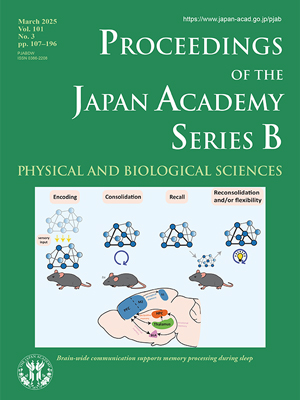About the Cover
Vol. 101 No. 3 (2025)
The review article in this issue (pp. 107–128) tackles the intricate relationship between sleep state and cognition, with a special focus on the role of the different sleep oscillatory patterns connecting multiple areas of the brain and supporting memory formation.
The top panel of this cover schematic illustrates the different stages of memory processing. When animals are awake, they actively process external stimuli through a variety of sensory modalities leading to learning, hence memory encoding. During subsequent offline (sleep) sessions, the neural patterns associated with experiences from wakefulness are spontaneously reactivated or replayed. These reactivations are essential for the strengthening of the neural memory ensembles in a process known as “memory consolidation” protecting them against interference. Intriguingly, not only memory stabilization takes place during sleep but also memory linking and the generation of new insights occurs.
The bottom panel summarizes the key brain regions (neocortex and hippocampus [HPC]) tied to different aspects of the memory process (declarative and perceptual). Structures such as the basolateral amygdala (BLA) and the thalamus further shape the emotional and sensory facets of memory, with multiple arrows emphasizing the bidirectional flow of information and the integrative aspect of memory formation. Different sleep oscillations, specifically their precise temporal nesting, are the orchestrators of this multi-regional communication coalescing cortical and subcortical regions working in tandem.
In this context, previous work by Dr. Miyamoto and colleagues focused on the consolidation of a tactile non-declarative memory processed in a cortico-cortical circuit in mice. The long-range bidirectional projections between the motor (M2) and somatosensory (S1) cortices were essential for learning during online states. Notably, only the frontal-sensory top-down input (M2 to S1) during non-rapid eye movement sleep was necessary for the long-term retention of this memory supported by slow wave-dependent reactivations.
Furthermore, on a microscale, the article gives an overview synaptic modulations (stability vs pruning) in top-down circuits as one of the pivotal underlying mechanisms of memory formation during the offline states.
In this review article, Said and Miyamoto provide an overview of the role of sleep in a wide variety of memory and cognitive processes as well as its underlying mechanisms.
Kaoru Inokuchi
Distinguished Professor, Graduate School of Medicine and Pharmaceutical Sciences, the University of Toyama




